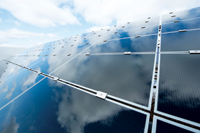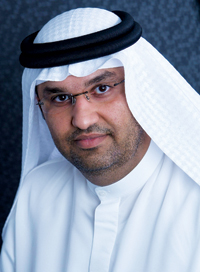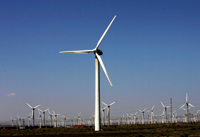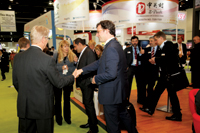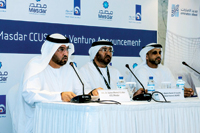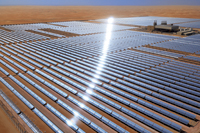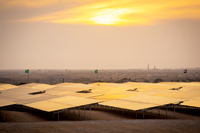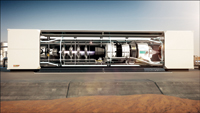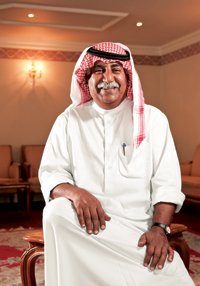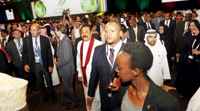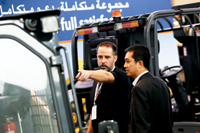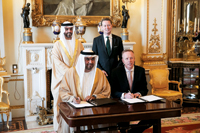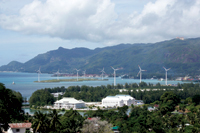
 WFES ... towards a sustainable tomorrow
WFES ... towards a sustainable tomorrow
EXHIBITORS in large numbers have signed up for the World Future Energy Summit 2014 (WFES 2014) amid increasing business opportunities in clean energy in the region brought about by a clear shift towards renewables.
With the search for sustainable energy solutions now topping the agendas of international governments, the world’s leading innovators in clean energy are making a beeline to exhibit at the 7th WFES, hosted by Masdar, from January 20 to 22, 2014 as a part of the Abu Dhabi Sustainability Week.
Organiser of WFES 2014, Reed Exhibitions, says over 90 per cent of the exhibition space has already been sold for next year’s event, with strong interest in the new Sustainable Living Area that will provide energy and water-efficient solutions for urban living, including a full-size eco-home, eco-transport models, and a fully-functioning hotel room.
The previous edition, WFES 2013, had featured over 650 companies from 40 countries, and WFES show director, Naji El Haddad, is confident of attracting even more exhibitors in 2014 based on the advanced bookings.
“Investment in renewable energy, particularly within the Middle East North Africa (Mena) region, is growing as more and more governments and private partners commit to large-scale clean energy projects,” says El Haddad.
“Indeed, the recent WFES insight report into solar energy development in Mena shows the huge potential for developing a large solar industry in the region due to its natural advantages of abundant sunshine and a strong power grid and road network. More importantly, the industry is strongly supported by governments that are committed to the development of clean energy sources to reduce their domestic reliance on fossil fuels,” says El Haddad.
Since its inception in 2008, WFES has grown to become the leading discussion platform for renewable energy, clean technology and sustainability, and it is now considered the pre-eminent international event for government and industry decision makers to find viable, sustainable solutions to the world’s growing energy challenges.
Hosted by Masdar, Abu Dhabi’s renewable energy company, WFES 2014 is the cornerstone of the Abu Dhabi Sustainability Week, the largest ever gathering on sustainability in the Middle East. The event comprises a world-class conference that offers an unparalleled forum for political, business and intellectual debate and a large-scale exhibition which facilitates networking and transactions between manufacturers, suppliers and customers across both the public and private sectors.
WFES has grown into a world-renowned, leading renewable energy, clean technology and sustainability platform, says El Haddad in an interview with OGN.
“Its main strength lies on the fact that it is capable of drawing global expertise, facilitating collaboration, forging partnership and connecting people who have the knowledge, the capital and the power to actually do something about the challenges and solutions towards a clean energy future,” he says.
Excerpts from the interview:
What have been the tangible gains from organising the World Future Energy Summit? Who has benefited from it?
The World Future Energy Summit has become the world’s preeminent gathering for renewable energy and the advancement of sustainable technologies. It is a platform for global collaboration where policy makers, business and technology leaders meet with innovators, investors, academics and researchers.
The conference programme offers in-depth analysis and debate of the key issues across renewable energy resources and energy efficiency, in particular, policy and regulation, and technology and innovation, and the exhibition space will be filled with developers and technology providers eager to collaborate.
Whether to win business, invest, network or simply learn more about the industry, WFES 2014 will allow the expected 1,000 delegates and approximately 30,000 attendees from all over the world, to explore opportunities in renewable energy and sustainable development.
 |
|
El Haddad ... bringing together expertise |
First of all, the conference programme. We expect key energy industry professionals from around the world to deliver thought-provoking and inspiring speeches on the most current and pressing topics, including waste-to-energy, the gas revolution, and, of course, the key subject of energy efficiency.
We’re also excited about the return of the Project & Finance Village and Sustainable Living Expo, as well as the introduction of our Business Matchmaking Programme.
The Project & Finance Village, introduced in 2011, was especially designed for project developers, entrepreneurs, banks and financiers to connect. With investment in the future energy market escalating, the small to large-scale projects being showcased at the Project & Finance Village at WFES 2014, supported by Bloomberg New Energy Finance, will provide the capacity to further increase the rate of clean energy adoption in the MENA region.
First displayed at WFES 2013, the Sustainable Living Expo returns to promote energy efficient solutions in the building and maintenance of our homes, offices and hotels, as well as more energy-efficient alternatives in everyday transport. At WFES 2014, our Sustainable Living Expo will feature an actual-size home, in partnership with ADEWA, fitted out with water and energy-saving features and incorporating renewable energy for electricity generation and water heating. The exhibit’s show home will appear alongside a hotel suite prototype sponsored by Rotana Hotels, which also adopts sustainable technologies. Both the home and hotel suite are designed and built by Genesis Manazil.
Finally, we will introduce our Business Matchmaking Programme, a new networking platform that matches a selected group of participants with decision makers attending the event to trade or source products. Those enrolled in the programme will receive a list of matching recommendations on who they should meet during the show for potential discussions and collaboration. In addition, a professional business matchmaker will be assigned to help BMP members set up meeting. Approximately 400 visitors have already registered.
Participation-wise how big will be WFES 2014 compared to other editions?
Since its inception in 2008, the World Future Energy Summit has grown considerably. As the centerpiece of Abu Dhabi Sustainability Week, the largest ever gathering on sustainability in the Middle East, the 7th edition of WFES next January is expected to be the largest edition to date.
In addition, the World Future Energy Summit will be co-located with the second International Water Summit and the inaugural EcoWASTE exhibition, ensuring address in a holistic way the 3 challenges for a sustainable future: energy demand, water shortage and waste disposal.
Together, these three events will enable 30,000 delegates and visitors and around 860 exhibiting companies to maximise networking and business opportunities, partnerships and global learning in the search for a more sustainable and equitable world.
What are the new things that you have added to WFES 2014 compared with the previous edition?
As mentioned (question 2), we are thrilled to see an even bigger and better Sustainable Living Expo, now with an eco-hotel, and to launch our Business Matchmaking Programme, which will certainly ensure participants leave WFES 2014 with concrete business prospects, instead of the usual business cards. We also look forward to Tech Talk, a stage for discussions, and all the ministerial and business meetings, announcement and launches that will take place during WFES 2014.
Why has EcoWASTE been added to the show?
Water, energy and waste are inextricably linked. Where there is an energy problem, there is most certainly a water problem, and vice versa. Where there is a concern about climate change, the concern is actually about both energy and water. The issues are interconnected, and so are the solutions. For example, municipal wastewater is not really waste; the water can be reused, and the solid waste can be used as a source of energy and fertiliser.
By taking a holistic view of the situation and addressing all three in a comprehensive way, practical and sustainable solutions can be found to address water, energy and waste concerns.
The interconnectivity of WFES, IWS and EcoWASTE will bring these communities under one roof and will encourage dialogue, solutions, business, innovation and research, technologies for a sustainable future.
What will be the key aspects of the Project and Finance Village?
The 2014 edition of our Project & Finance village will be all about interactivity and innovation.
The International Renewable Energy Agency (Irena) will present two sessions. The first one, together with the Abu Dhabi Fund for Development, will showcase results of the first round of project funding and discuss the evaluation process and methodologies for the next round. The second, will be a demonstration of the first full-fledged project navigator software for developers and financing. Middle East Solar Industry Association (MESIA) and the Clean Energy Business Council (CEBC), will also be present, talking about the financing of solar projects in the Middle East. These are only a few of the very interesting topics to be discussed at the Project & Finance Village.
In terms of renewable energy projects, we expect over 25 to be displayed.
How has WFES contributed to the growth of renewables in the region?
The World Future Energy Summit has grown into a world-renowned, leading renewable energy, clean technology and sustainability platform. Its main strength lies on the fact that it is capable of drawing global expertise, facilitating collaboration, forging partnership and connecting people who have the knowledge, the capital and the power to actually do something about the challenges and solutions towards a clean energy future.
How successful have the GCC countries been in finding the right energy mix? After the initial enthusiasm, is there a slowdown in the pace of renewable adoption by the Gulf countries? If so, why?
With the current decline in production, export commitments and slow discovery of oilfields, Gulf countries have been forced to invest in alternate energy sources to meet demand, but weaning societies away from oil and gas is certainly extremely challenging.
While the region is learning and has set high targets for solar power generation over the next two decades, it does need time to build its regional project development, engineering, procurement, construction, grid integration and maintenance capabilities.
Governments need to adopt clear and consistent policies in order to get private investors onboard and reduce the need for government funding, and domestic banks have to benchmark against their international counterparts in order to gain the experience they lack to finance solar projects.
I guess one could say GCC countries have all the natural advantages, with abundant sunshine and a power grid and road network that could lead to the development of a very large solar industry. They also have governments determined to invest. The difficulty lies in execution.
Which country has topped in the adoption of renewables in its energy mix?
The UAE has certainly led the way in ambitious renewable energy projects in the GCC. According to Frost & Sullivan, here are some of the main projects and numbers: Abu Dhabi Shams1 project for 100 MW, the Mohammed bin Rashed Solar Park in Dubai with a proposed capacity of 1000 MW by 2030 and Abu Dhabi’s plan to achieve 7 per cent of electricity generation from renewable sources by 2020, amounting to nearly 1500 MW of power from renewable to be achieved over the next nine years, with an expected investment of $7-10 billion in these projects.
In Mena, I would highlight the efforts in Morocco. Recent findings in the World Future Energy Summit Insight Report 2013: “Realising the Promise of Solar Industry Development in the Middle East and North Africa” show the country aims to generate 42 per cent of electricity from renewable energy sources by 2020, with the government launching major programmes and a private sector that is encouraged by initiatives like the EnergiPro, with guaranteed access to the grid and incentive tariffs for any excess electricity produced.
Where in the region do you see renewables being embraced aggressively in the coming years?
Again, I have to highlight the UAE, for all the obvious reasons mentioned above.
Saudi Arabia also has ambitious plans for alternate energies, with investment amounts that might reach $109 billion. Some projects include: 3.5 MW power plant to be built by Aramco, 100 MW solar Makkah project, 600 MW Dibba 1 IPP project, which could be the kingdom’s first concentrated solar power integrated combined cycle plant, plus several initiatives like using solar power in control panel devices to fend off pipeline corrosion, doing trials to power a village and school with solar power and the upcoming polysilicon production facilities in the country.
And here, I am glad to announce a very strong presence of KSA at WFES through King Abdullah City for Atomic and Renewable Energy (KA.CARE), ACWA Power, King Abdullah University of Science and Technology (Kaust), in addition to hundreds of attendees from the private and public sector in the kingdom.
Another initiative that deserves credit is Kuwait’s 60 MW Al Abdaliyah Integrated Solar Combined Cycle.










































































